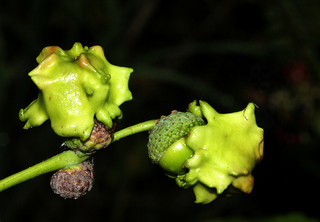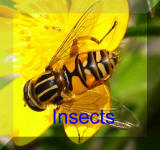Knopper Gall Andricus quercuscalicis
Hymenoptera: Cynipidae
Description Forms on corns of our native Pedunculate Oak; forming in August they are sticky and red, later becoming woody and brown. A second generation then develops in the catkins of Turkey Oak.
The Gall Appearance
The large 2 cm gall growth appears as a mass of green to yellowish-green, ridged, at first sticky plant tissue on the bud of the oak, that breaks out as the gall between the cup and the acorn. If only a few grubs are developing within, then it may appear only as a group of bland folds. Where several grubs are competing for space the shape may become much more contorted, with several tightly bunched galls
The derivation of the term comes from the german word 'knoppe' meaning a kind of felt cap or helmet worn during the 17th-century; also a small rounded protuberance, often decorative, such as a stud, a tassel or a knob.
Similar GallsAlthough normally distinctive the knopper gall can, under some growth conditions, be mistaken for the acorn cup gall, caused by the gall wasp Andricus grossulariae
The Gall Wasp
Habitat Anywhere where the host tree - Oak is present.


